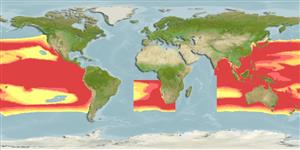Environment: milieu / climate zone / depth range / distribution range
Ecology
Marine; pelagic-oceanic; oceanodromous (Ref. 51243); depth range 1 - 320 m (Ref. 58302). Tropical
Indo-Pacific: Japan and northwestern Hawaiian Is., east and west coast of Australia, Rapa and Easter Is.; and from the Gulf of California to Peru.
Size / Weight / Age
Maturity: Lm ? range ? - ? cm
Max length : 50.0 cm FL male/unsexed; (Ref. 7097); common length : 30.0 cm Fl male/unsexed; (Ref. 9283)
Adults are pelagic (Ref. 58302), in oceanic and inshore waters (Ref. 9563) forming schools (Ref. 9283). They feed mainly on planktonic invertebrates (Ref. 9283). Marketed fresh and salted or dried (Ref. 9283).
Life cycle and mating behavior
Maturity | Reproduction | Spawning | Eggs | Fecundity | Larvae
Edwards, A., 1990. Fish and fisheries of Saint Helena Island. Centre for Tropical Coastal Management Studies, University of Newcastle upon Tyne, England. (Ref. 5288)
IUCN Red List Status (Ref. 130435: Version 2024-1)
Threat to humans
Harmless
Human uses
Fisheries: commercial; gamefish: yes; bait: usually
Tools
Special reports
Download XML
Internet sources
Estimates based on models
Preferred temperature (Ref.
123201): 14.1 - 28.1, mean 23.6 °C (based on 1345 cells).
Phylogenetic diversity index (Ref.
82804): PD
50 = 0.5010 [Uniqueness, from 0.5 = low to 2.0 = high].
Bayesian length-weight: a=0.01122 (0.00514 - 0.02450), b=3.04 (2.87 - 3.21), in cm total length, based on all LWR estimates for this body shape (Ref.
93245).
Trophic level (Ref.
69278): 3.4 ±0.45 se; based on food items.
Resilience (Ref.
120179): Medium, minimum population doubling time 1.4 - 4.4 years (Preliminary K or Fecundity.).
Fishing Vulnerability (Ref.
59153): Moderate vulnerability (42 of 100).
Nutrients (Ref.
124155): Calcium = 481 [159, 1,454] mg/100g; Iron = 4.95 [1.76, 11.62] mg/100g; Protein = 19.9 [18.5, 21.4] %; Omega3 = 0.369 [0.177, 0.790] g/100g; Selenium = 98.4 [31.3, 289.6] μg/100g; VitaminA = 15 [4, 62] μg/100g; Zinc = 1.28 [0.72, 2.35] mg/100g (wet weight);
